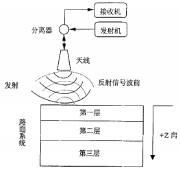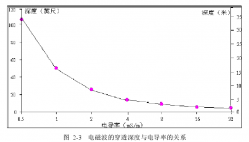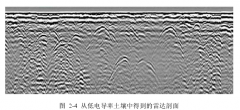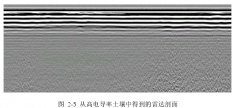论文总字数:24634字
摘 要
自改革开放以来,国家对道路交通等基础设施建设的投入大大增加,我国的道路建设发展迅猛,成就也是举世瞩目的。随着新建道路的不断建设施工,也随之产生了一系列新的问题。近几年来,频繁出现新建道路寿命短、质量差、返修率高的情况。全国各地发生的多起重大道路桥梁坍塌事故不仅给国民经济造成巨大损失,还时刻严重威胁着人民群众的生命财产安全。因此道路工程质量检测工作逐渐受到各建设单位、监理单位、设计单位的重视,道路建设阶段和建成后期的质量检测和评价的任务也逐渐加剧。
然而我国目前采用的道路质量检测方法多为传统的检测方法,根据相应的要求随机选取测点位置、钻芯、取样,并进行数据的分析和处理,对厚度、含水量、强度等各项指标进行抽样检测。传统的道路工程质量检测方法存在着相当大的局限,如:测点随机,代表性较差;只能以点带面,局部不达标;测速慢、周期长、效率低;成本高且钻孔取样会对路面造成一定程度的破坏等。更严重的是在后期的运营维护中,存在于道路结构内部的隐性病害如道路内部积水、空洞或疏松等若不能被及时地检测出来,往往会导致道路结构破损加剧。随着新建道路规模的扩大及养护里程的增加,问题将越来越突出,已不能适应道路工程的建设速度。
因此我们急需研究出一种新型的快速高效的道路质量检测方法,来提高道路工程的质量水平,减少危害事故的发生。
路用探地雷达(Ground Penetrating Radar,简称GPR)是一种先进的道路质量无损检测技术,与传统的检测方法相比具有探测速度快(80km/h)、分辨率较高、携带方便、探测过程连续、可实时成像,且对路面不产生破坏等优点,受到工程界的青睐,并逐渐应用于道路等市政工程的质量检测工作中。
本文从电磁学基本理论出发,详述了GPR的发展历程、组成结构和工作原理,介绍了其在国内外道路工程质量检测方面的研究现状,并结合具体工程实例探讨了路用GPR在道路工程中的应用。
本文的主要内容和研究成果如下:
1、简述了国内外GPR的发展历程以及路用GPR的应用现状,引出本文的研究背景,并明确了GPR在道路质量无损检测方面的优越性和发展趋势。
2、系统介绍了GPR的结构组成,并从电磁学基本原理出发,详述了路用GPR的工作原理,具体包括电磁波传播特性、路用GPR的探测性能及参数分析、地下介质的电特性分析、土层介质中水的影响及反射波信号质量的影响因素分析等。
3、较为详细地介绍了GPR在道路工程质量评价中的应用,即道路结构层厚度检测、压实度与含水量评价、新铺沥青路面的质量控制及路面损坏状况调查。重点详述了运用GPR技术检测道路结构层厚度和识别刚性混凝土路面板下的脱空病害的原理及研究方法,并结合实际工程对其进行检验。
关键词
路用探地雷达;介电常数;无损检测;结构层厚度检测;隐藏缺陷;脱空识别;
Abstract
Since the reform and opening up, our country has greatly increased the investment in road transportation. Road engineering, as the key infrastructure of a country, has obtained large achievements with the fast development of economy. Recently, as more and more road engineering has been constructed, many problems appear. In recent years, new roads frequently appeared the situation of short service life, poor quality and high repair rate. There are many road and bridge collapse accident occurred in our country, not only caused huge losses to the national economy, but also seriously threatened to the people's life and property security. Therefore the construction units, supervision units and design units pay more attention to the road engineering quality inspection work gradually. The work of road quality inspection and quality evaluation has increased more and more during the road construction stage and the post completion stage.
However, the road quality detection methods adopted in China are mostly conventional detection methods. Randomly select the location of the measuring points according to the corresponding requirements, drill core, take samples, make data analysis and processing and do sampling detection to the indicators such as thickness, water content, strength and etc. There are considerable limitations in the conventional road engineering quality detection method, such as the random and sparse layout of measuring points, partial non-compliance, slow speed measurement, long period, low efficiency, high cost and the damage to the pavement. Furthermore, in the late operation and maintenance, the hidden diseases such as the internal water and cavity within the road turns difficult to find out, leading to the heavy failure of road engineering. Alone with the expansion of the new road scale and the increase of the maintenance mileage, the problem will become more and more outstanding.
So we need to work out a new fast and efficient road quality detection method to improve the quality of road engineering and reduce the occurrence of damage accident.
The ground penetrating radar (GPR for short) is a new nondestructive detection technique in road engineering. It has attracted wide attention in engineering field, owing to the following advantages, such as its complete detection items, fast detection speed, high sample density, real-time imaging processing, and no harm to pavement. Thus GPR has been applied in the quality detection of road engineering and other municipal engineering gradually.
Based on the basic theory of electromagnetics, this paper gives a systematic introduction of the structural composition and working principle of GPR. Then a quite detailed description and analysis has been carried out from the theoretical degree on the application of GPR in road engineering.
The main works and achievements of this paper are listed below.
- This paper has given a holistic introduction of the origin and history of GPR, as well as the application status of road GPR, which extracts the research background and identifies the significance and contents of research work.
- A comprehensive description of the structural composition of GPR system has been done. Then an introduction of the working principle of road GPR is carried out with the basic electromagnetics theory. It is detailed from the several following aspects, the propagating characteristics of electromagnetic wave, the detection performance and detection parameter analysis, the electrical characteristics analysis of subsurface medium, effect of water in soil medium and the influence factor of reflection wave signals quality, etc.
- The application of GPR in road engineering quality evaluation is introduced in detail, including the detection on the layer thickness of road structure, the evaluation of compactness and moisture content, quality control of new asphalt pavement and the investigation of pavement damage. A comprehensive description of the theory and research methods of using GPR to detect the layer thickness of road structure and to identify the void under rigid concrete plate.
Key words
Road GPR; dielectric constant; nondestructive detection; structure thickness detection; hidden disease; void identification.
目录
摘要 I
Abstract III
目录 V
目录 错误!未定义书签。
1 绪论 1
1.1 研究背景 1
1.2 国内外研究与应用现状 2
1.2.1 GPR技术的发展历程 2
1.2.2 路用GPR的应用现状 3
1.3 本文的研究内容与方法 5
1.3.1 研究意义 5
1.3.2 研究内容与技术路线 5
2 路用GPR的工作原理 7
2.1 概述 7
2.2 路用GPR的结构组成及工作原理 7
2.2.1 路用GPR的结构组成 7
2.2.2 路用GPR的电磁学原理 8
2.2.3 路用GPR的探测原理 11
2.3 路用GPR的探测性能及参数分析 12
2.3.1 路用GPR的探测性能 12
2.3.2 路用GPR的探测性能参数分析 13
2.4 地下介质的电特性分析 15
2.4.1 介电常数 15
15
2.4.2 电导率 15
15
2.5 土层介质中水的影响 17
2.5.1 水对土层介质介电常数的影响 17
2.5.2 水对反射回波波形的影响 17
2.6 反射波信号的影响因素分析 19
2.6.1 GPR系统的因素 19
2.6.2 天线结构的因素 19
2.6.3 电缆配置的因素 20
2.7 本章小结 20
3 路用GPR在道路工程质量检测中的应用 21
3.1 概述 21
3.2 结构层厚度检测 21
3.3 路面损坏状况调查 24
3.4 新铺沥青路面的质量控制 27
3.5 含水量和压实度评价 27
3.6 本章小结 28
4 结论与展望 29
4.1 主要结论 29
4.2 进一步研究方向与展望 29
参考文献 31
致 谢 32
1 绪论
1.1 研究背景
道路交通建设工程是国家大力投资的重要基础设施,其建设水平密切影响到人民群众的生命财产安全、城市的社会生活乃至整个国民经济的发展走向。但近几年来,频繁出现新建道路寿命短、质量差、返修率高的情况。全国各地发生的多起重特大道路桥梁坍塌事故不仅给国民经济造成了巨大损失、严重影响道路的安全运行,还时刻威胁着人民群众的生命和财产安全。因而我们急需研究出一种新型的快速有效的道路工程质量检测方法,来提高道路工程的质量水平,减少危害事故的发生。
传统的道路工程质量检测方法分为两类种:一种是表观几何尺寸的检测,借助如直尺、水准仪、平整度仪、经纬仪等专业测绘仪器进行的无损检测;一种是工程试验检测,对已投入使用的道路或施工过程中的面层、基层、垫层、路基进行厚度、压实度、含水量、稳定度、抗压、抗折强度、弯沉值的抽样检测。前一类检测方法易行,但不能对内部隐藏结构进行评价,也无法对工程力学指标性能做出评价。后一类检测方法存在效率低、成本高、不具代表性且会对路面造成损坏等问题,而对存在于路表一下道路结构层内部的隐性病害如积水、空洞或基础疏松等有时不能及时地检测出来,在日积月累的冲压下将会进一步导致道路结构层破损加剧。对此,我们急需研究出一种更为安全、高效的道路工程质量无损检测技术,来提高道路建设质量和养护管理水平,减少危害事故的发生。
路用探地雷达(Ground Penetrating Radar,简称GPR),是应用地球物理学的一个分支,通过向地下发射高频短脉冲形式的宽带电磁波来探测地表下介质或不可视物体内部介质分布规律的无损探测方法。
剩余内容已隐藏,请支付后下载全文,论文总字数:24634字
相关图片展示:





该课题毕业论文、开题报告、外文翻译、程序设计、图纸设计等资料可联系客服协助查找;


